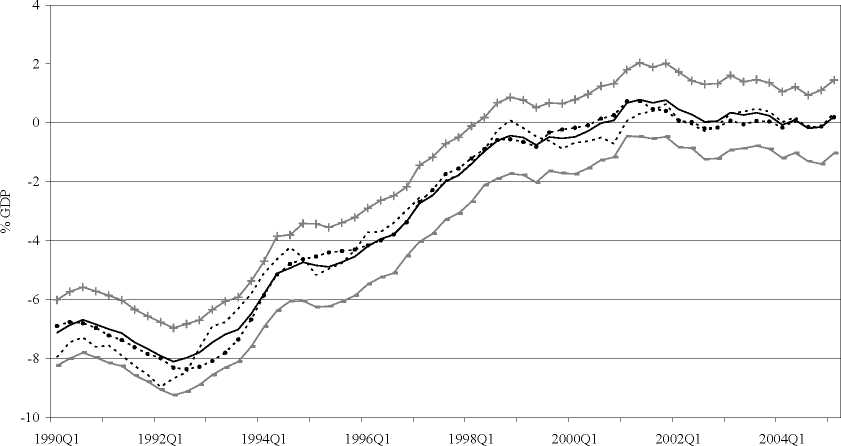The Netherlands is the only country to include both zero and 3 per cent within the real
time 95 per cent confidence interval in the last 5 years of our sample. It is hence the only
country where we are statistically unable to see whether or not it is likely to meet one or
both of its treaty and Council commitments. However, even given the uncertainty about
the current cyclical position, which is greater here than in most other countries (except
perhaps France) we can be reasonably sure that the surplus we currently see has some
structural component and is unlikely, at the 95 per cent confidence level, to involve an
underlying deficit position in breach of the 3 per cent floor. However, in 2003 for a
period the budget deficit was sufficiently large that it is unlikely that it could be explained
by cyclical factors, in that the bounds did not include zero.
The uncertainty surrounding the output gap estimate in Belgium is noticeably lower than
in the Netherlands, and we can be relatively sure, at the 95 per cent level, that the current
position represents a structurally adjusted budget deficit of somewhere between -1.5 and
+1.5 per cent of GDP.
Figure 7.7 Belgium - Budget Deficit Cyclical Adjustment - Real Time

BGGBR outturn -----BGGBR-Cyclically adjusted —I- BGGBR-adjusted upper bound
BGGBR-adjusted lower bound......BGGBR-adjusted full sample
197
More intriguing information
1. Climate change, mitigation and adaptation: the case of the Murray–Darling Basin in Australia2. The name is absent
3. Fiscal Policy Rules in Practice
4. Intertemporal Risk Management Decisions of Farmers under Preference, Market, and Policy Dynamics
5. Public-private sector pay differentials in a devolved Scotland
6. Improving the Impact of Market Reform on Agricultural Productivity in Africa: How Institutional Design Makes a Difference
7. Creating a 2000 IES-LFS Database in Stata
8. Testing the Information Matrix Equality with Robust Estimators
9. For Whom is MAI? A theoretical Perspective on Multilateral Agreements on Investments
10. The name is absent